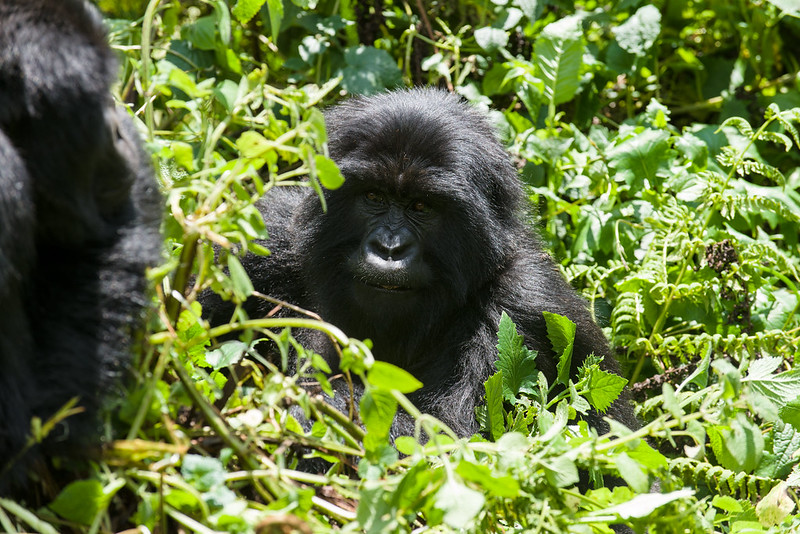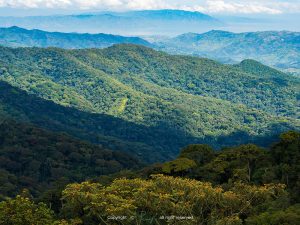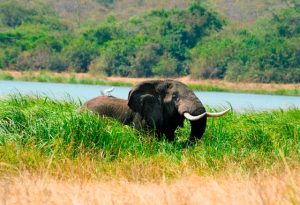Volcanoes National Park
Volcanoes National Park, located at nearly 15,000 feet in the Virunga Massif, is covered with lush green rainforest. The park is named after the chain of dormant volcanoes that make up the Virunga Massif: Karisimbi, the highest at 4,507 meters, Bisoke with its verdant crater lake, Sabinyo, Gahinga, and Muhabura.
In northwest Rwanda, Volcanoes National Park protects the steep slopes of this magnificent mountain range, home to the endangered mountain gorilla. The park features a rich mosaic of montane ecosystems, including evergreen and bamboo forests, open grassland, swamps, and heath. The most fascinating activity is Mountain Gorilla Trekking, with over 40 permits issued each day. A maximum of eight people can visit each habituated gorilla group, alongside the endemic golden monkeys living in the park.
Uganda and Rwanda offer the best destinations for Gorilla Safaris in Africa. Gorilla tourism is crucial to these countries, and they work hard to maintain a safe environment for their tourism industries to flourish. There are specific rules and guidelines to follow for safety, and the gorillas that are tracked and visited have been habituated to tolerate human presence.
Vegetation and Wildlife in Volcanoes National Park
Volcanoes National Park has distinctive vegetation zones at various elevations, each with unique plant species. From 2400-2500 meters above sea level, there is the lower montane forest, mostly pristine farmlands. From 2600-3200 meters, a Neoboutonia forest and Bamboo forest form 30% of the vegetation at this altitude, followed by Hagenia woodland and then the Hypericum zone. At 3500-4200 meters, there is the Lobelia zone, and from 4300-4500 meters, there are thickets, marshes, and non-woody plants (grassland).
Besides mountain gorillas, the park is home to various animals, including forest elephants, buffaloes, bush pigs, giant forest hogs, duikers, spotted hyenas, bushbucks, and several primates.
Mountain Gorillas
Volcanoes National Park hosts 10 habituated families of endangered mountain gorillas for tourists to visit. Tracking these gorillas is an adventurous and memorable opportunity, offering a wonderful and exciting encounter with these giant apes.
Gorilla Groups in Volcanoes National Park
There are several gorilla families in Volcanoes National Park. To track gorillas, you need to purchase a permit before embarking on this experience. Each group has a name and is led by a silverback.
Amahoro gorilla group
Led by Ubumwe, known for its peaceful nature. This group resides uphill, requiring a steep climb.
Hirwa gorilla group: Formed from members of Group 13, Susa, and Sabyinyo. Led by Munyinya.
Sabyinyo gorilla group
Led by Guhonda, this group is closest to the park headquarters, suitable for shorter treks.
Kwitonda gorilla group
Migrated from the Democratic Republic of Congo, led by silverback Kwitonda. This group is moderately difficult to trek.
Group 13/Agashya gorilla group
Originally had 13 members, now led by Agashya with about 25 members.
Umubano gorilla group
Led by Charles, who broke off from the Amahoro group.
Ugenda gorilla group
Known for roaming around the Karisimbi area.
Susa (A) gorilla group
The largest group in the park with 41 gorillas, studied by Dian Fossey.
Karisimbi/Susa – B gorilla group
Split from the original Susa (A) group, residing on Mt. Karisimbi.
Titus gorilla group
Named after silverback Titus, born during Dian Fossey’s research.
Bwenge gorilla group
Formed by Bwenge, occupies the slopes between Karisimbi and Bisoke mountains.
Birds of Volcanoes National Park
Volcanoes National Park is home to over 200 bird species, including several Albertine Rift endemics. Birding enthusiasts can look for species such as Grauer’s rush warbler, Rwenzori batis, Rwenzori turaco, and others.
Activities/Attractions in Volcanoes National Park
Volcanoes National Park is a top destination in Rwanda, with mountain gorillas being the main attraction. However, there is more to the park than gorilla trekking.
Gorilla Trekking
Offers a thrilling and unforgettable wildlife experience.
Golden Monkey Trekking
These monkeys live in the bamboo zone and stay in groups of up to 40.
Birding Safaris
The park hosts over 90 bird species, including 13 endemic to the Virunga and Rwenzori mountains.
Hiking the Dian Fossey Tomb
Explore the legacy of Dian Fossey, who dedicated her life to mountain gorilla conservation.
Mountain Hiking and Nature Walks
Offers views of the Virunga mountain chain and local stories.
Cultural Encounters
Visit local markets, projects, and households to experience Rwandan culture.
Accommodation
The park has many accommodation options, ensuring a comfortable stay:
Mountain View Gorilla Lodge
Gorillas Nest Lodge
Virunga Lodge
Le Palme Hotel Rwanda
Kinigi Guest House
Le Bambou Gorilla Lodge
How to Get to the Park
By Road: The park is in Musanze (Ruhengeri), accessible by public transport from Gisenyi or Kigali. The drive is about 2 hours.
Best Time to Visit
The park can be visited year-round, but the drier months (June to mid-September and December to February) are preferred for gorilla trekking. During the rainy seasons (March-May and October-November), the trails can be slippery and muddy. However, the rainy season is ideal for birding, photography, and enjoying the lush scenery.




